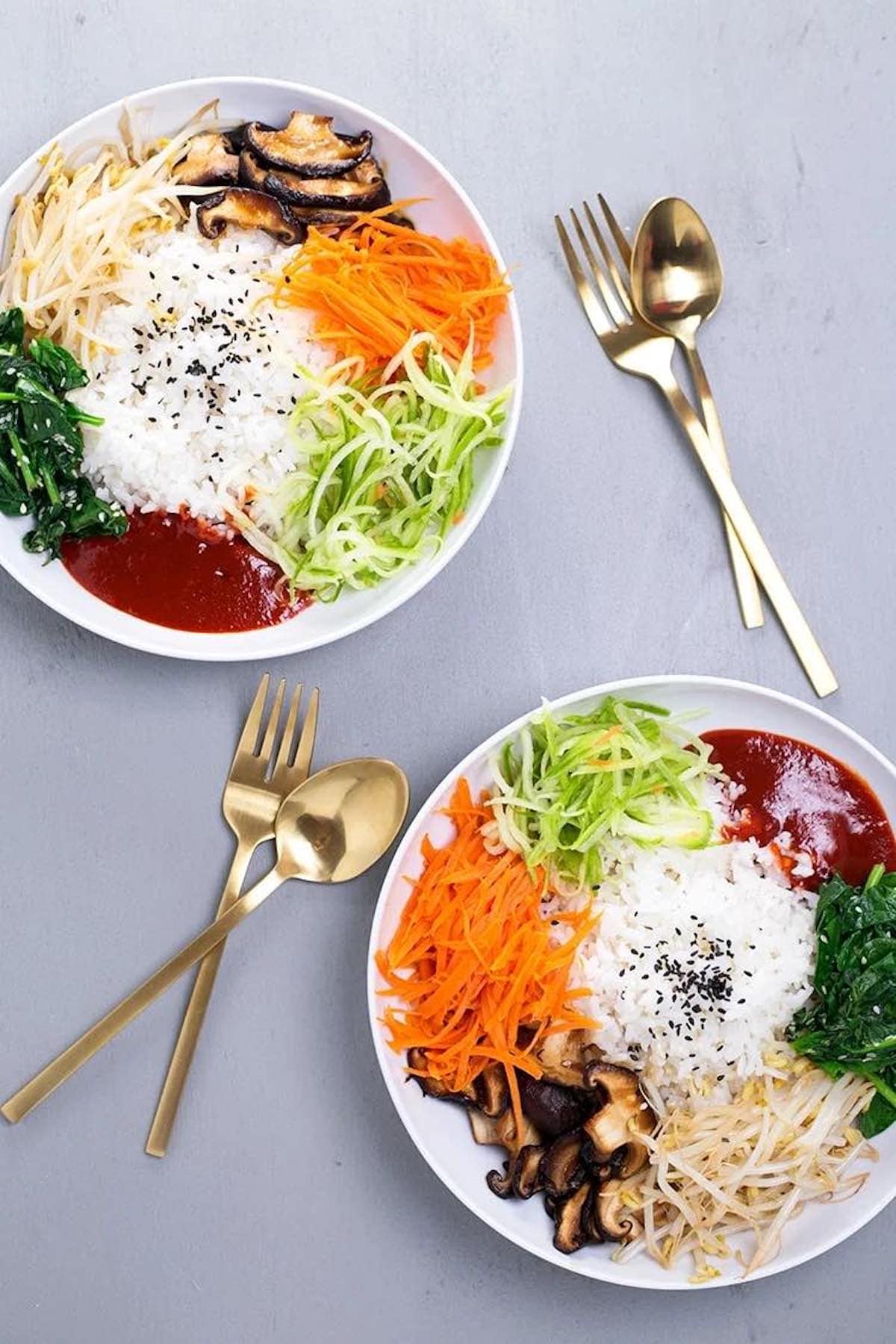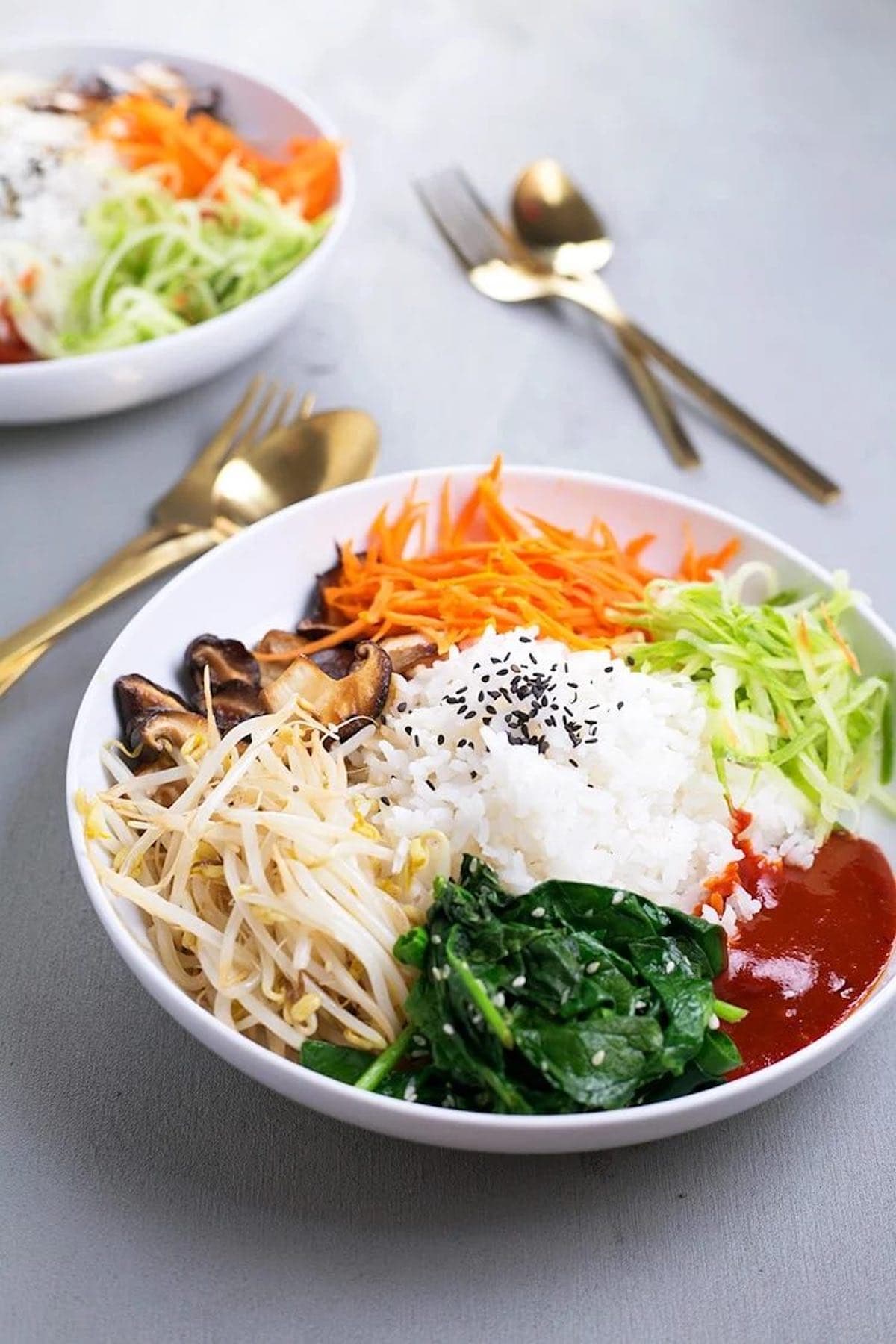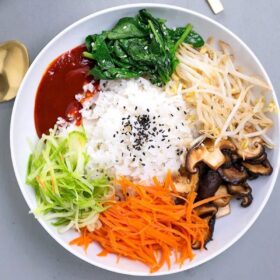Learn to make this vegan bibimbap; incredibly flavorful, filling, and highly nutritious. An excellent way to get in your daily servings of vegetables!

We love recreating vegan versions of all-time favorite recipes. If you’ve tried our soda bread and pesto pasta, brace your taste buds for this vegan bibimbap recipe.
It’s a healthy and delicious combination of flavors you’ll love!
FREE EBOOK SERIES! 5 SECRETS FOR FOOLPROOF VEGAN DESERTS
What is bibimbap?
Vegan bibimbap is a vegan version of the popular Korean dish, bibimbap. It is made with steamed white rice, sautéed vegetables such as mushrooms, carrots, spinach, and bean sprouts, and a spicy sauce made with gochujang, which is a spicy Korean chili paste.
While the traditional version typically uses beef, we made it completely plant-based without sacrificing the flavor!
Why this recipe works
- Budget-friendly. It only uses easy-to-find and affordable ingredients.
- Easy. From prep to plate, this recipe only needs 5 steps and minutes to prepare.
- Healthy. Bibimbap is famous for being full of wholesome and fresh ingredients, including vegetables and wholegrain.
- Versatile. Alter the ingredients, and serve it hot or cold for dinner, lunch, or appetizer. It’s a super versatile dish!
What I love most about this recipe is that it allows me to utilize any leftover vegetables (which I have a ton of) and turn them into a fancy dinner without letting any go to waste!
Ingredients needed
While the ingredient list may look a little long, it actually uses simple ones you can find at any mainstream grocery store.
- Medium grain white rice. Cooked.
- Shiitake Mushrooms. Sliced.
- Tamari. For a rich umami flavor.
- Brown sugar. To add sweetness.
- Mirin. Adds tanginess.
- Carrots. Thin strips.
- Salt. To season.
- Sesame oil. For a nutty taste.
- Baby spinach. Chopped.
- Bean Sprouts. You can use soybean sprouts aswell.
- Cucumber. Thinly sliced strips.
For the gochujang chili sauce
- Gochujang. For the base
- Sesame oil. Or any other neutral flavored oil.
- Brown sugar. To balance the flavor.
- Tamari. Traditional Japanese sauce.
- Rice vinegar. You can also use regular white vinegar.
How to make vegan bibimbap
In just 5 simple steps, this bibimbap recipe will be ready to enjoy. Here is how you can make it:
Step 1: Prepare the mushrooms
Heat up a pan and add in mirin, tamari and brown sugar. Let it cook on medium heat till the mushrooms have absorbed the seasonings well. Set it aside and move on to prepare the remaining veggies.
Step 2: Prepare the veggies
In a heated pan, add your carrots along with sesame oil and salt. Let the carrots wilt a little, which shouldn’t take more than 30 seconds. Once done, remove hat carrots and individually repeat the same process with the spinach and bean sprouts.
Step 3: Prepare the gochujang chili sauce
In a mixing bowl, add in the tamari, gochujang, brown sugar, rice vinegar, and sesame oil and give it a quick whisk ensuring everything is smoothly combined.
Step 4: Assemble
In the middle of the plate, heap a pile of warm rice and around it, arrange your cooked carrot, mushrooms, spinach, gochujang chili sauce, bean sprout, and cucumber.

Tips to make the best recipe
- Be mindful of the gochujang you use, as it may contain fish or oyster sauce. Check the ingredients to purchase a vegan version.
- Bibimbap is traditionally served hot. So, heat the dish before serving to get the best flavor and texture.
- To add more flavor to your vegan bibimbap, cook rice in vegetable broth.
Variations
Want to experiment with the flavor of your bibimbap? Here are a few ways:
- Use different mushrooms. To alter the flavor, you can replace shiitake mushrooms with other edible mushrooms such as button and emoji mushrooms.
- Use various grains. You can use different types of grains as the base, such as quinoa or brown rice, instead of traditional white rice.
- Add more protein. Add tofu to bibimbap by crumbling or garnishing before serving. It’s a great way to add extra protein and texture to the dish.
Storage instructions
To store. Packed in an airtight container, covered, it can be stored in the refrigerator for 3-5 days.
To freeze. Put it in a freezer-safe container and freeze for up to 2 months.
Reheating. Reheat in the microwave for 2-3 minutes before serving.
More dinner recipes to try
Frequently asked questions
Gochujang is a Korean fermented chili paste, commonly used in Korean cuisine. Some varieties of gochujang may be vegan, but many contain ingredients such as fish sauce, oyster sauce, or honey, which is not suitable for vegans.
Bibimbap is a Korean dish that typically includes a mix of vegetables, meat, and a fried egg on top of rice. However, not all bibimbap dishes include an egg. Some variations may omit the egg or replace it with other protein ingredients such as tofu or seafood.
In a bowl of vegan bibimbap, you get around 350 calories.

Vegan Bibimbap
Ingredients
- 1 1/2 cups White rice cooked
- 1 1/2 cups Shiitake Mushrooms sliced
- 2 tablespoons Tamari
- 2 teaspoons Brown Sugar
- 1 tablespoon Mirin
- 1/2 cup carrots julienned
- 1/8 teaspoon Salt
- 1/4 teaspoon Sesame Oil
- 2 cups Baby Spinach
- 1/8 teaspoon Salt
- 1/4 teaspoon Sesame Oil
- 1 cup Bean Sprouts
- 1/8 teaspoon Salt
- 1/4 teaspoon Sesame Oil
- 1/2 cup cucumber julienned
For the chili sauce
- 2 tablespoons Gochujang you can find a Gluten Free variety here
- 1 teaspoon Sesame Oil
- 2 teaspoons Brown Sugar
- 1 teaspoon Tamari
- 1 1/2 teaspoons Rice Vinegar
Instructions
- To prepare Shiitake mushrooms, place slices in a hot pan and add Tamari, Brown Sugar and Mirin. Cook on medium heat until mushrooms have wilted and absorbed seasoning. Set aside whilst preparing remaining vegetables.
- To prepare your Julienned Carrot Strips, place in a hot pan with salt and sesame oil. Cook for 30 seconds or until lightly wilted. Immediately remove from pan and repeat this cooking process with the Bean Sprouts and Spinach.
- To prepare Gochujang Chilli Sauce, whisk all ingredients in a bowl till smooth.
- To serve, place a mound of warm cooked rice in the middle of a plate and arrange prepared Mushrooms, Carrot, Bean Sprouts, Spinach, Cucumber and Gochujang chilli sauce.
- Garnish rice with black and white sesame seeds. Stir everything up and enjoy!
Hillary says
Amrita says
Ashley says
Amrita says
Camilla says
Amrita says
fifi says
Epices et délices says
Amrita @ Crazy Vegan Kitchen says
mila furman says